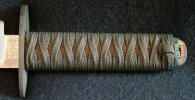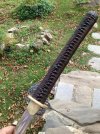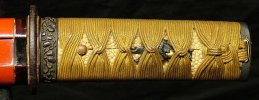So, probably not the absolute best place for this post, but I figure I'll get more answers and less hate here than a dedicated nihonto forum. But if anyone knows of a better place for answers to this please let me know 
I have started doing tsukamaki for some projects I am working on. And I decided to forgo traditional methods and materials for two reasons. One: it's not worth the time and cost. And two: my alternative has a better feel to it, in my opinion.
My alternative is to use paracord over the traditionally wider silk cord. I am also eschewing hishigami. The result, when done right, looks decent and provides what I feel is a much better grip. So it is essentially just 1/8 inch nylon cord twisted and then overlapped to create the diamond pattern. The problem is that despite my best efforts I can not get consistent results. Occasionally I get one, sometimes two crosses that come out just PERFECTLY. But no effort on my part can reproduce the effect. Many come out looking just stupid and even if I undo it and try again I cannot get better results. So the overall result looks more haphazard slap dash.
So I'm wondering if any of you out there have any experience in this and would be willing to share any advice for getting a higher quality result.
I have started doing tsukamaki for some projects I am working on. And I decided to forgo traditional methods and materials for two reasons. One: it's not worth the time and cost. And two: my alternative has a better feel to it, in my opinion.
My alternative is to use paracord over the traditionally wider silk cord. I am also eschewing hishigami. The result, when done right, looks decent and provides what I feel is a much better grip. So it is essentially just 1/8 inch nylon cord twisted and then overlapped to create the diamond pattern. The problem is that despite my best efforts I can not get consistent results. Occasionally I get one, sometimes two crosses that come out just PERFECTLY. But no effort on my part can reproduce the effect. Many come out looking just stupid and even if I undo it and try again I cannot get better results. So the overall result looks more haphazard slap dash.
So I'm wondering if any of you out there have any experience in this and would be willing to share any advice for getting a higher quality result.





